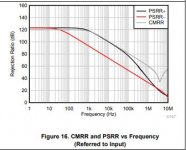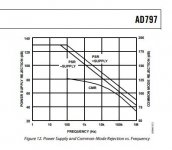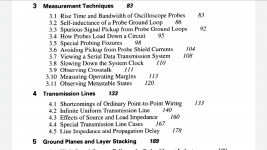I have only one true interest ... line level preamps. I see them as the control stage of a system. My dream is the most transparent and so universal line stage. For line stages psu quality is of paramount importance ... ok there are some op-amps with very high psrr trhoughout the band ... but i like more discrete circuits. I would like to start from psu ... both single and dual. And then try some schematics i have at hand.Every part has noise, except absolute cold ones ( about absolute zero temperature).
If it is too 'noisy' or not depends on exact circuit requirements (but not on absolute noise level).
LM317 and it's sisters have RMS output noise voltage of 0.003% Vo (output-dependent). It can be less than 0.1 mV RMS at 12 VDC (with 5 MHz range).
So in fact you made choices beforehand and it won't matter if there are way better solutions? With the new insight 🙂 that all parts exhibit noise you will understand that all regulators exhibit noise and some exhibit less noise than others. In audio you want as least noise as possible. This means that the best PSU is good enough for optimal results regardless if the circuit has tubes, opamps, is discrete built or it is even digital. When predefining certain choices (and using stuff/schematics one has at hand) maybe that goal can not be met....
That ideal line stage can be omitted with sources younger than 10 years....Any modern source puts out 2Veff and can have loads till 10 kOhm. In general power amplifiers have input impedances that are way higher than 10 kOhm. Less is more, certainly in analog.
That ideal line stage can be omitted with sources younger than 10 years....Any modern source puts out 2Veff and can have loads till 10 kOhm. In general power amplifiers have input impedances that are way higher than 10 kOhm. Less is more, certainly in analog.
Last edited:
I don't claim to have top performance. Now I'm using for example on my little line preamp a power supply made with just an EI transformer and a kit using a LM317. Based on what explained to me and i've seen on the datasheet, the LM317 has a pretty good psrr up to 1-5kHz and declining at higher frequencies.So in fact you made choices beforehand and it won't matter if there are way better solutions? With the new insight 🙂 that all parts exhibit noise you will understand that all regulators exhibit noise and some exhibit less noise than others. In audio you want as least noise as possible. This means that the best PSU is good enough for optimal results regardless if the circuit has tubes, opamps, is discrete built or it is even digital. When predefining certain choices (and using stuff/schematics one has at hand) maybe that goal can not be met....
Then i have discovered the cap multiplier ... a revelation. When correctly designed and built it can take care very well of the ripple right at the frequencies where the LM317 is weakest.
I see the two circuits completely complementary ... and very simple to put together.
In the next days i will be simulating some cap multiplier with LTspice ... even if i have already some very good circuits to try. I have seen a nice darlington with hfe=5000 ... the 2sd2390
Checked that the voltage drop is not high on the CM i could even put two ... one before the LM regulator stage and one after ... it's a bit complicated but it can be done
A high end regulator will definitely have a higher wideband psrr but I have heard they are more prone to oscillate ? a thing that I do not understand well but worries me ...
i guess you mean a passive preamp ? i did some test with two pots some years ago ... a 10klog Alps blue and a 20klog stepped attenuator (with Holco resistor)That ideal line stage can be omitted with sources younger than 10 years....Any modern source puts out 2Veff and can have loads till 10 kOhm. In general power amplifiers have input impedances that are way higher than 10 kOhm. Less is more, certainly in analog.
The stepped attenuator was unbelievably transparent but the lower ohm pot provided a fuller bass.
On that basis i wuould like to try a very low resistance attenuator ... like 5Kohm or even 2.5kohm logaritmic ...
I think that that could work
In the next days i will start buying a cheap 2.5k log pot to try out at the inputs of the power amp 🙄
Maybe it could be the only think i really need ? 😱
Thanks a lot again.
Last edited:
Keep it around 20 kOhm for use with most sources.
No PSU with whatever regulators = no added ripple/noise/power on or power off phenomenons/no extra coupling caps with their own sound character. The drawback is the lack of pages full of discussion about LM317/LM337.
Tip: always keep at least 1 coupling cap between volume control and power amplifier in case something goes wrong. No DC on speakers is good.
No PSU with whatever regulators = no added ripple/noise/power on or power off phenomenons/no extra coupling caps with their own sound character. The drawback is the lack of pages full of discussion about LM317/LM337.
Tip: always keep at least 1 coupling cap between volume control and power amplifier in case something goes wrong. No DC on speakers is good.
Last edited:
Thank you very much again. The source most probably will be a dacKeep it around 20 kOhm for use with most sources.
So i could select a dac with a very strong output ?
I heard something about the advantage to keep the pot resistance very low ... but i lost the paper. Something about S/N ratio maybe ?
now you are confusing me ... you start mentioning high psrr and end on "sound character" ? what is that ? 😕 😉No PSU with whatever regulators = no added ripple/noise/power on or power off phenomenons/no extra coupling caps with their own sound character. The drawback is the lack of pages full of discussion about LM317/LM337.
I believe this ... noise is noise ... always. And noise is not music ... is a disturb
Zero noise ... is the ultimate dream. That blacker background that anyone dreams about. So no question ... the less the noise the better.
I promise myself also to put up a system to measure this f... noise. But the lower the noise the more difficult to measure of course.
I have seen around very impressive noise floors ... i guess a lot depends also on some new op-amps that have an impressive psrr wideband. Like the opa1656 very popular these days
But also the old ad797 is quite impressive psrr wise.
I have no clue about discrete circuits psrr performance.
Thank YouTip: always keep at least 1 coupling cap between volume control and power amplifier in case something goes wrong. No DC on speakers is good.

Attachments
Last edited:
Truly, get a copy of a D. Self "small signal audio design" book. This will help you get an understanding of what are the sources of noise in audio and their relative importance.
At line level, you don't need very low noise power supplies, unless you use a design with a completely awful psrr.
At line level, you don't need very low noise power supplies, unless you use a design with a completely awful psrr.
Truly, get a copy of a D. Self "small signal audio design" book. This will help you get an understanding of what are the sources of noise in audio and their relative importance
Hi ! thanks a lot for the valuable advice. I promise myself to study a little more but now my main aim is LTspice applied to psu I have the feeling that it is a very powerful tool ...
Thanks again, I have to say that post #304 of this thread has been a life changer for me. I would have never imagined that a cap multiplier could provide the psrr performance in the attached picAt line level, you don't need very low noise power supplies, unless you use a design with a completely awful psrr
Then i became aware that a LM317 is noisy ... and this complicates a little the all issue. But i will check this noise and listen if it is tolerable.
Yes i am only interested in line level application. But a line preamp can make or destroy the sound very easily. Especially soundstage.
Attachments
LTspice is a very powerful tool indeed. But, as with all simulators, you need to know what to feed it and how to interpret the results correctly. Don't make the mistake I did myself when starting this hobby, spending too much time with the simulator without understanding sufficiently the basics.
LTspice is a very powerful tool indeed. But, as with all simulators, you need to know what to feed it and how to interpret the results correctly. Don't make the mistake I did myself when starting this hobby, spending too much time with the simulator without understanding sufficiently the basics.
Hi ! thanks a lot for the advice. Let's say that the plot is very promising
And moreover i have seen darlingtons with 1000 to 5000 of hfe ... they seem born to multiply capacitance 😱
I could try a two stages regulator ... the first stage with a zener diode to set the voltage needed and the second a CM ... both with the same darlington
And skipping on the noisy LM ... hoping that the darlington is less noisy 😱
You will afraid of noise long time until you can measure a noise and until you know how to make a low-noise design.Then i became aware that a LM317 is noisy ... and this complicates a little the all issue.
It was suggested a good book above (D. Self "small signal audio design" book). I can add one more, for example: Ott Henry. Noise Reduction Techniques in Electronic Systems.
And the third one: High Speed Digital Design: A Handbook of Black Magic. (! 🙂 )
Those three books are like 'bibles' how to do things right.
Last edited:
The books to read first are school books.
Old ones are right, newer and internet is mostly junk especially videos.
Go at libraries. These places at township's and universities where there are these, called books.
Old ones are right, newer and internet is mostly junk especially videos.
Go at libraries. These places at township's and universities where there are these, called books.
You will afraid of noise long time until you can measure a noise and until you know how to make a low-noise design.
It was suggested a good book above (D. Self "small signal audio design" book). I can add one more, for example: Ott Henry. Noise Reduction Techniques in Electronic Systems.
And the third one: High Speed Digital Design: A Handbook of Black Magic. (! 🙂 )
Those three books are like 'bibles' how to do things right.
Hi ! thank you very much for your kind and precious advice. Since i have become aware of this LTspice sw i really would like to start from there and then try to simulate some very simple circuits.
I am fascinating by this sw that can take care of all the dreadful calculations behind circuit designs.
I am asking in another thread about opions on how well results from sim correlate with actual measurements on a prototype. Here would be completely out of topic.
So speaking of power supplies i am also interested in a handbook book that explain the basics and propose some schematics.
Thanks a lot again.
Have a nice day, gino
Last edited:
For the basics, the art of electronics by Horowitz and Hill is a classic. Rather pricey though so try to find it at a library or used.
I (still) don't have the Self book, though I'm sure it's good. I recall paging through the Ott book years ago, it seemed impenetrable, I'll have to look again.You will afraid of noise long time until you can measure a noise and until you know how to make a low-noise design.
It was suggested a good book above (D. Self "small signal audio design" book). I can add one more, for example: Ott Henry. Noise Reduction Techniques in Electronic Systems.
And the third one: High Speed Digital Design: A Handbook of Black Magic. (! 🙂 )
Those three books are like 'bibles' how to do things right.
"High Speed Digital Design" is indeed very good, but seems to have a narrow focus which has no overlap with this thread, or indeed most audio. If you're doing FPGA, high speed DAC/ADC or maybe even ARM embedded design, it's good for learning good board layout and other techniques to reduce onboard-generated noise to the point where it won't create glitches in such circuits. That's reducing hundreds of millivolts to millivolts, but still nowhere near the microvolts and nanovolts that "SOTA HIFI AUDIO" demands. I'd recommend it only AFTER going through:
Yes, this. Get the Third Edition if you can. We have a thread on it:For the basics, the art of electronics by Horowitz and Hill is a classic. Rather pricey though so try to find it at a library or used.
The Art of Electronics 3rd Ed. April 2015
The books to read first are school books.
Old ones are right, newer and internet is mostly junk especially videos.
Go at libraries. These places at township's and universities where there are these, called books.
This post feels like a truth bomb exploding 🙂
Hi ! thanks a lot ... bigThe books to read first are school books.
Old ones are right, newer and internet is mostly junk especially videos.
Go at libraries. These places at township's and universities where there are these, called books.
 The basics. But even the basics can be quite difficult. I will try to get a help from sim sw.
The basics. But even the basics can be quite difficult. I will try to get a help from sim sw. I am much more limited than lazy. I swear. I am slow at understanding math. And electronics are math.
Oh, I forgot. The important is to understand, reading is not enough. Needless to say, watching videos and tutos is useless.
Simulation as a learning tool: Yes.
You don't wait for parts, they don't blow up and you see what happens.
Simulation as a learning tool: Yes.
You don't wait for parts, they don't blow up and you see what happens.
Last edited:
- No, I don't agree. A half or more then a half of the book is about how to do things right (but not about digital design). A difference between low-speed analog cirquits and high-speed circuits is minimal."High Speed Digital Design" is indeed very good, but seems to have a narrow focus which has no overlap with this thread, or indeed most audio.
Here is a part of it's content:
Attachments
Last edited:
I see no benefit to going crazy and complex over power supply designs, particularly to power line-level circuits, and RF stages. A simple cap-multiplier filter before an LMxxxx regulator, ...
Not after ? i wonder which of the two stages will generate more noise.
I would put the noisier stage first ? 🙄
- Home
- Amplifiers
- Power Supplies
- Are you really fine with IC voltage regulators ?



